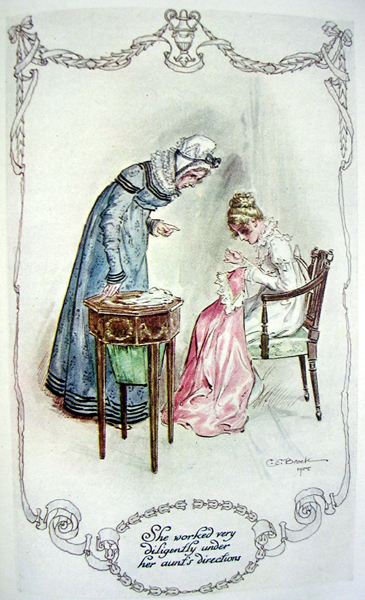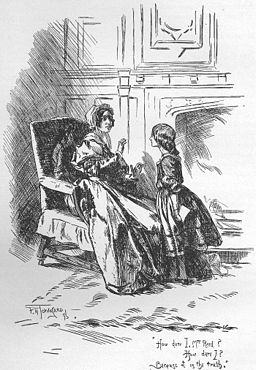
“Cut down an avenue! What a pity! Does not it make you think of Cowper? ‘Ye fallen avenues, once more I mourn your fate unmerited.'”
Seven Literary Aunts of Orphans
Have you ever noticed how often literary orphans are equipped with aunts? These aunts generally fall into two of four categories: Good, Bad, Controlling and Crazy.
[Note: since most of these aunts have been known to the world for decades if not centuries, I make no apology for spoilers. You have been warned…]

Jane Austen starts us off with Mansfield Park (1814), containing a pair of aunts – sort of. Fanny Price has two maternal aunts, but her Aunt Bertram is laid back almost to the point of nonexistence (she operates more as a plot device than a practical person). This lack is more than made up for by the virulence of Fanny’s Aunt Norris, who most definitely falls under the heading of Controlling. And as even her virtues (thrift, for example) seem to be founded on poor motivations, I personally have no qualms in classifying her as a Bad Aunt.
Charlotte Brontë had no difficulty, in 1847, in outdoing Austen’s creation with her own aunt of Gothic awfulness: Jane Eyre‘s Aunt Reed. She treats her niece as a semi-servant, allows her spoilt children to maltreat their cousin, and eventually packs her off to a typhoid-ridden school she is lucky to survive. (“Eight years! you must be tenacious of life,” as Mr Rochester subsequently remarks.) And then, still blaming Jane for the animosity she feels, she deliberately lies to separate Jane from the only relative who cares for her. Clearly, a Bad Aunt, and Controlling too.

Three years later, Charles Dickens produced Miss Betsey Trotwood, a great-aunt whose exceeding eccentricity causes her to storm out of the house on discovering her niece has produced a male of the species. On the other hand, she takes her great-nephew David Copperfield in when he becomes an unwanted orphan (feeding him “aniseed water, anchovy sauce, and salad dressing” to comfort his tears). She also gets him off to a good start in life. A Good Aunt, all things considered, but definitely heading toward the Crazy section.
1876 (the nineteenth century was well-provided with both aunts and orphans) saw an American aunt arise, from the pen of Mark Twain: Tom Sawyer‘s Aunt Polly. A stern woman, perhaps, but her heart is in the right place. One thinks of the incident of the cat and the patent medicine (see Chapter XII). Overall, a Good Aunt, albeit somewhat Controlling.

Jumping into the twentieth century, we meet two of the craziest aunts of all time in Joseph Kesselring‘s Arsenic and Old Lace (1939). Mortimer Brewster’s Aunt Martha and Aunt Abby are the sweetest, kindliest, gentlest homicidal maniacs imaginable. Leading lights in the Crazy category, but possibly still candidates for the Good section, depending on how you define goodness. On the one hand, very caring and hospitable. On the other hand, serial killers. I leave it to you to decide.
1961 brought us two of the nastiest aunts, from the imagination of Roald Dahl; viz James‘ Aunts Spiker and Sponge. They take Aunt Reed’s worst ideas and run with them, perpetrating what can only be classified as child abuse. Definitely Controlling, definitely Bad, and definitely high on the list of People Who Deserve to Be Fatally Flattened by Fruit.

Last on the list is Princess Lily’s Aunt Hortensia (ETA 2018) who illustrates the principle that meaning well is not always the same as doing well. She is undeniably Controlling (Young Ladies Do Not Argue is one of her favourite maxims) but on the other hand, she has her reasons. Over the years, I have come to feel rather sorry for Aunt Hortensia. I’m sure she’s a lovely lady deep down, but years of fear and denying herself for Duty have had their effect on her. I shall be bold, however, and claim for her a place among the Good Aunts.
Who are your favourite – or most-loathed – aunts of orphans? Share in the comments!
Literary Handwork
Reading and handwork make a perfect pair, in my opinion: the two things I enjoy doing most, miraculously combined. Sometimes I even enjoy the reading more than actually doing the thing itself. And on those occasions when a project outlasts enthusiasm, what better to rekindle the fires than finding the same spark in a book?

Happily, literature is full of examples of hand-workers – particularly in those classics which were written in the days when handwork for women was just ‘work’ and everyone (unless a gentleman of the purely decorative class) was expected to keep themselves busy.
So it is with the Dashwood girls in Sense and Sensibility. “Sir John Middleton, who called on them every day for the first fortnight, and who was not in the habit of seeing much occupation at home, could not conceal his amazement on finding them always employed.”
Or take Mansfield Park, also by Jane Austen. One of her more underrated books, I feel, with one of her more underrated heroines. Fanny is always busy with handwork: her own, or someone else’s. Helping Aunt Bertram the indolent, or being press-ganged into the thrifty machinations of Aunt Norris. And unlike her cousins, she does work of a high calibre.
 Then there are the March girls in Little Women, who ” adopted Jo’s plan of dividing the long seams [of sheets] into four parts, and calling the quarters Europe, Asia, Africa, and America, and in that way got on capitally, especially when they talked about the different countries as they stitched their way through them.” The book also includes knitting, dressmaking (for humans and dolls), and the embroidering of a pair of slippers (“grave yet cheerful pansies on a deeper purple ground”).
Then there are the March girls in Little Women, who ” adopted Jo’s plan of dividing the long seams [of sheets] into four parts, and calling the quarters Europe, Asia, Africa, and America, and in that way got on capitally, especially when they talked about the different countries as they stitched their way through them.” The book also includes knitting, dressmaking (for humans and dolls), and the embroidering of a pair of slippers (“grave yet cheerful pansies on a deeper purple ground”).
Not all literary hand-workers are enthusiastic. Catherine, from Catherine, Called Birdy by Karen Cushman, is continually being nagged by her old nurse Morwenna to work on her spinning, sewing, embroidery and the like, when she would rather be running wild outside. “They found the remains of several spindles, many skeins of wool, and an unfinished tapestry in the muck from the privy. Why is everyone so certain they are mine?”

Other fictional handworkers include Miss Silver, who is always knitting something, usually for her great-niece or great-nephews, and who designs and executes her own crochet trimmings to boot. Miss Marple also knits, but in less detail. Devotées (or, indeed, devotés) of quilting can enjoy the works of Jennifer Chiaverini and Earlene Fowler. Embroiderers, or those considering taking up embroidery, should make a beeline for Embroidery Mary.
On the non-fiction side, there are plenty of books about the history and practice of various crafts, and then there are books of craft humour. Stephanie Pearl-McPhee is an outstanding outlier in this field.
For those who are passionate about both literature and craft, there are books of crafts inspired by books, which you can add another layer to by making the crafts from the books of crafts inspired by books. While reading the originatory books, if you want to complete the circle and you have the much-desired (by me at least) ability of reading while working with your hands.
 Alternatively, you can follow the grand old tradition of having one person read while everyone else handworks; or its modern, more solitary equivalent: the audio book.
Alternatively, you can follow the grand old tradition of having one person read while everyone else handworks; or its modern, more solitary equivalent: the audio book.
What are some of your favourite handworky books? Recommendations eagerly sought!
